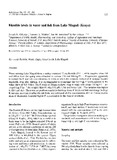| dc.contributor.author | Gikunju, Joseph K | |
| dc.contributor.author | Maitho, Timothy E | |
| dc.contributor.author | Birkeland, Jan M | |
| dc.contributor.author | Lökken, Per | |
| dc.date.accessioned | 2013-06-13T13:05:00Z | |
| dc.date.available | 2013-06-13T13:05:00Z | |
| dc.date.issued | 1992 | |
| dc.identifier.citation | Joseph K. Gikunju, Timotey E. Maitho, Jan M. Birkeland, Per Lökken (1992). Fluoride levels in water and fish from Lake Magadi (Kenya). Hydrobiologia May 1992, Volume 234, Issue 2, pp 123-127 | en |
| dc.identifier.uri | http://link.springer.com/article/10.1007/BF00010867 | |
| dc.identifier.uri | http://erepository.uonbi.ac.ke:8080/xmlui/handle/123456789/33178 | |
| dc.description.abstract | Water entering Lake Magadi from a spring contained 73 mg fluoride (F)1-1, while samples taken 100 and 400 m from the spring were estimated to contain 110 and 140 mg F 1-1. Evaporation apparently increased the F and salt concentrations to levels at which the common method of F analyses became unreliable, even after dilution. It is recommended to re-examine the very high F levels reported in the saline lakes of Rift Valley. The F levels of Tilapia grahami living in water with about 110 mg F 1-1 averaged (mg F kg-1 dry weight): fillet 68, skin 819, gills 1,366 and bones 1,661. The variation was highest in fillet and skin. There was no positive correlation between tissue F levels and fish size (range 3–20 g). It remains uncertain whether the fish bone was saturated at this concentration of F or if some mechanism of elimination hindered higher F accumulation in the skeletal structures. | en |
| dc.language.iso | en | en |
| dc.title | Fluoride levels in water and fish from Lake Magadi (Kenya) | en |
| dc.type | Article | en |

